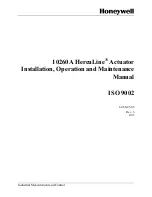
10260A Series Actuators Installation, Operations, and Maintenance Manual
2
10260A Series Actuators – Installation, Operations, and Maintenance
2/03
the change in position. Sensing is accomplished by changing the magnetic field created by the coils in the
sensing circuit board. There is no contact between circuit board and spoilers.
1.3.2 Slidewire Emulation
Introduction
A truly unique feature, slidewire emulation allows direct replacement of existing three-wire control
actuators without requiring controller changes while gaining all of the advantages of the maintenance-free
non-contact sensing. This is ideal for replacement of installed actuators that cause control problems due to
slidewire wear.
Description
The slidewire emulation assembly consists of a non-contact position sensor, an output board, and a bracket
as shown in Figure 1-2. The position sensor is identical to that described in Section 1.3.1.
A potentiometric voltage from the controller is supplied to the slidewire emulation circuit. This voltage is
ratiometrically conditioned with respect to the output shaft position from 0 % to 100 % and is available to
the controller. Voltages of 1 Vdc to 20 Vdc are accepted and this device will emulate 100 ohm to 1000
ohm slidewires.
1.3.3 Film Potentiometer
Introduction
Film potentiometer position sensing eliminates maintenance problems and nuisance shutdowns common
with slidewire and wiper assembly for position sensing.
Description
The film potentiometer is connected directly to the output shaft reflecting true shaft position. The film
potentiometer is 1000 ohms over the actuator’s 90 degree travel. Other ohmic values can be accomplished
using an appropriate shunting resistor.
1.3.4 Motor Positioner Board
Introduction
The Honeywell Motor Positioner Board accepts a current input signal to provide internal closed loop
control of the position of the actuator. The Honeywell Motor Positioner makes positive position control
possible with current output controllers.
Description
The Motor Positioner operates raise/lower switch contacts (triacs) which control power to the reversing
motor in the actuator. The actuators integral Non-Contact Sensor or Film Potentiometer provide the
position feedback signal to the Motor Positioner. Input signal ranges are adjustable from 0.2 Vdc to 1 Vdc,
up to 1 Vdc to 5 Vdc. By use of an appropriate shunt resistor, controller current outputs of 4-20 mA dc, 1-5
mA dc, 10-50 mA dc, can be achieved.
Fail-safe features are also provided. On loss of input signal, the Motor Positioner may be preset to drive the
motor upscale, downscale, to a particular position, or to stop where it is. In the event of actuator NCS
failure (broken wiper) or film potentiometer broken wiper, the Motor Positioner can be set to drive the
motor fully upscale or downscale. The Motor Positioner will also accept slidewire input. For
master/follower applications, the Motor Positioner will position a “follower” actuator in accordance with a
slidewire input signal from a “master” actuator. The ratio between master and follower movement is
Содержание HercuLine 10260A
Страница 10: ...x 10260A Series Actuators Installation Operations and Maintenance 2 03 ...
Страница 36: ......













































